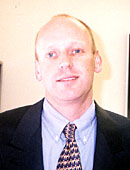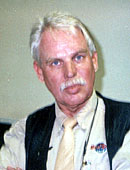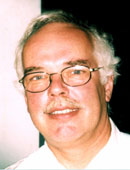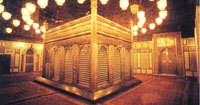
Mr. Hans Akerboom, Second Se cretary of the embassy and Mr. Dick A.J.ter Steege, IHS resident representative in Yemen and team leader of the present program: Yemeni People Must Have Knowledge to Preserve their Cultural Heritage [Archives:2000/51/Interview]
December 18 2000


The government of the Netherlands is one of the most important contributors to the development in Yemen. It is not only economic-oriented aid that the Dutch give to Yemen, but also the preservation of the Yemeni cultural heritage. They have now some projects in many places of Yemen targeting the old cities, museums and mosques in terms of preserving and revitalizing them.
After an international tender, the Dutch embassy in Sanaa signed a contract on November 26, 2000 with the Institute for Housing and Urban Development Studies (IHS) in Rotterdam, Holland. The objective of this program is to assist the government of Yemen in guiding the revitalization process of its historic cities.
To shed more light on the activities of the Dutch in preserving the Yemeni cultural heritage including this program, Mohammed Hatem Al-Qadhi of Yemen Times talked to Mr. Hans Akerboom, Second Secretary of the embassy and Mr. Dick A.J.ter Steege, IHS resident representative in Yemen and team leader of the present program and filed the following interview. Excerpts.
Q: Could you please tell us a little bit about role of the Dutch in preserving Yemens cultural heritage?
A: The Dutch government supports preservation of the Yemeni cultural heritage because we think that Yemen is gifted with a beautiful cultural heritage and it is important for the Yemeni people to have knowledge to preserve their own culture. That is why we are one of the biggest donors in the field of culture, promoting and especially sponsoring projects like the Cultural Heritage Program for which a contract was signed with the IHS which won the tender. They have experts from Holland, Yemen like Mr. Ali A. Oshaish acting as deputy team leader and experts from other countries. Yemens involvement in the project is very big.
Q: What is the focus of the project?
A: The focus of the project is actually related to urban cultural heritage and that is complementary to other activities in cultural heritage. It is directed to the historic cities of Yemen. The program consists of three main categories: First, it is related to institutional development which means that the present stakeholders will be assessed to see their roles, how they cooperate, where are the voids and overlaps in the collaboration between the organizations. On this basis we would make a proposal to smoothen the way cultural activities can be implemented and in that way we are related to urban planning and management.
The second category targets policy development for urban cultural heritage and the development of tools for implementation. The third one aims at community development and awareness.
Q: When will the project start?
A: The project consists of two phases; the first one started on the first of November 2000. It is actually defining and determining what activities are going on to be implemented in the remaining program. It will take a period of around 6 months and the implementation phase will take-5 years.
The program is initially financed by the Dutch government. In total an amount of 4.4 million Dutch guilders( US$ 1.7 million) will be spent. But is important to say that this program is working as catalyst to other donors. So, a number of program parts will be defined and co-financed by the other donors in addition to pilot projects that will be financed by this program.
Q: Are there any Dutch archaeological teams working in Yemen?
A: Actually archaeology and urban development are two different things, though we are related because the present cities are usually also part of archaeological sites. There are two different activities, however, we would like to link them as far as documentation is concerned to see whether all information available and so in the future will be accessible to all for that also part of our program will be the establishment of a documentation center in which all this information can be accessible to all who need for either research or for all kinds of practical purposes…etc.
Q: When will the center be established?
A: It is on of those activities to take place within the coming 4-5 years. In fact, the proposal for this center will be presented within the coming six months and the implementation will depend on how the proposal will be composed as it is not yet there and we are working on it at the moment?
Q: Is there any cooperation between you and other western organizations working in the same field?
A: Yes, we have requested at the moment the Italian and German teams working under the guidance of the World Bank as well as GTZ to have discussions with them. We are also working with the National Museum and the American Institute for Yemeni Studies to see where we can link all information systems that are there and are related to development. We are also looking for further contacts with other donor organizations.
Q: How do you think the Yemeni private sector can help preserve the cultural heritage?
A: The private sector will in future play a main role in protecting the cultural heritage. So, that means there will be a differentiation in the roles of the government and private sector and it is important that there is a close cooperation between them. In that sense the government in future will be more a facilitating entity. The private sector should be ensured that when it does invest it has a return on its investments and that will encourage the private sector to continue in this field. In this way, there will be very strong emphasis on trying to involve the private sector in the preservation of historic cities. Also the NGOs and CBOs( Community Based Organizations) will play an important role in the development and the implementation of the program.
Q: How do you look at the way the Yemeni people deal with their heritage?
A: I am afraid that at the moment people hardly realize how many assets they have. Therefore, one of the target of our program is to try to see whether we can make people more aware of what is happening and is present in Yemen. This is because there is so much in the form of tradition and built cultural heritage which is right now neglected and not taken as a real asset that can be economically used. In this way, there will be a possibility for revitalizing the historic cities of Yemen.
This heritage is important for tourism and research. Recently Yemen is a tourist destination for European people only . It should be so for Arab people who can see their roots of history in Yemen. This will help expand the scope of tourism
Q: Are you doing some other projects in the field of protecting heritage?
A: Yes, we are one of the biggest donors in the field of cultural heritage and we do several projects. One of the main projects besides the cultural heritage program is the national museum restoration, the Al-Ameryah old mosque and its wall paintings restoration, the restoration of Sayon old palace and lately also the development of a proposal for the establishment of a museum in Marib. We are also looking for other opportunities to help Yemeni people reserve their heritage.
Q: What is the amount of money singled out by you to this field?
A: It is between $ 6-7 million. It is quite a lot of money. In this we assist the Yemeni people preserve their cultural heritage and make them aware of the beautifulness they have in their country. We try also to make Yemen and its beauty known to the Dutch in Holland through media and this hopefully will attract more people coming from Holland to visit Yemen as tourists or businessmen.
Yemen has been an international tourist destination even in the past. But as a result of a number of political changes in the recent years especially after 1994, tourism went down. But the political climate is becoming more stable and calm and people will be much more likely to come to Yemen. I believe there is a joint effort not only by the Ministry of Tourism but also by the government of Yemen as a whole to keep this stable situation and to make clear what the assets of the country are. In this sense we are confident that tourism will increase in the future. But all the facilities to be required for tourism have to be in line with what the competition is offering. In our opinion only a limited part of the possibilities of Yemen are used and a larger scope can be used in future especially Yemens beaches ..etc which can be competitive to many other places like Egypt.

On this occasion, the Dutch Ambassador in Sanaa, H. E. Bert J. Ronhaar said: It is a very important activity during the lifetime of the project. WE with the Yemeni people and government will be able to improve the awareness towards the cultural heritage either of the pre-Islamic or the Islamic periods. The Dutch interest in cultural heritage is that we have a very long standing relation with Yemen. It is a deeply-rooted relation in history when Yemen was an important producer of coffee that was introduced to Europe from Mukha and in our development cooperation quite importance is that to assist in the preservation of the cultural values and identity as it contributes to the self-esteem of the people and the country. A part of the identity of the country is embodied in the buildings, they way towns have been built and villages are being set up. WE consider it important to keep that as much as possible intact to be able to show to the people how things were in the past and how they developed it in the present and to be aware of how it can be used. It is should not be a living museum only but also an important part of modern society and I think that is the major aim of this project.
——
[archive-e:51-v:2000-y:2000-d:2000-12-18-p:./2000/iss51/intrview.htm]


